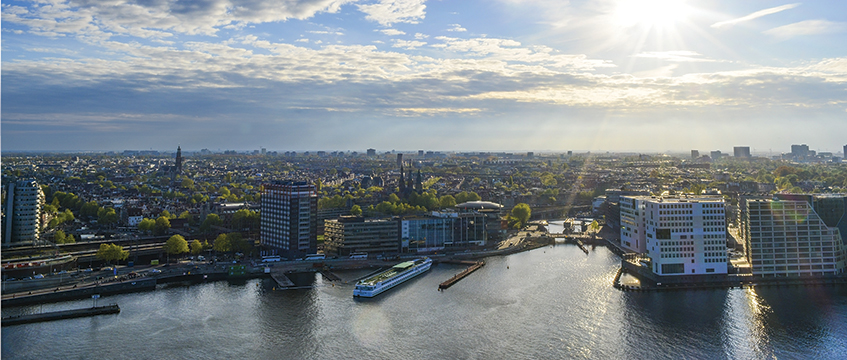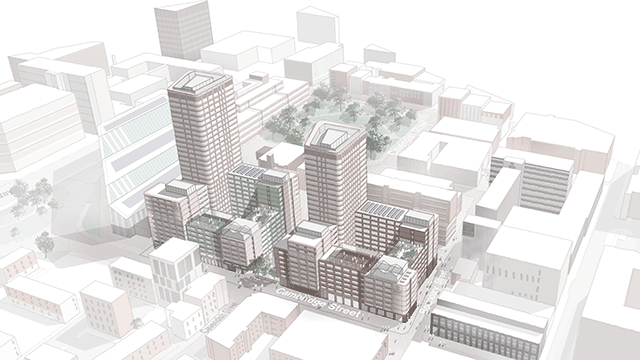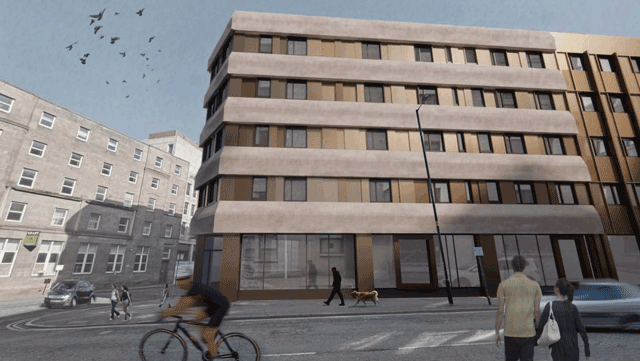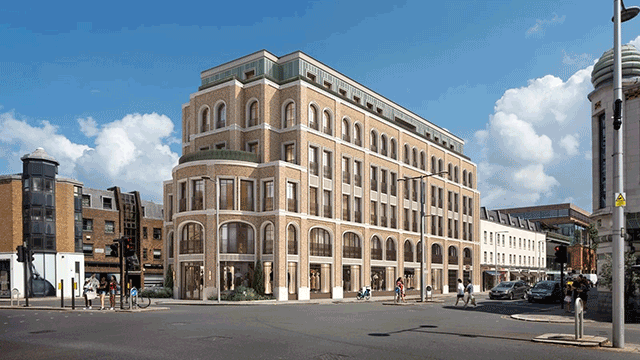When it comes to bouncebackability, the performance of real estate in the Netherlands is a prime example of a sector on the up.
Having just overtaken Spain to become the fourth most active European market for foreign investment in the first half of the year, a 17% rise in funds being ploughed into property marks a significant turning point for a country that was hit particularly hard when the global financial crisis took hold a decade ago.
With close to €10bn (£9bn) invested in the country between January and June, according to Real Capital Analytics, it has bucked a wider trend, as investment into European property as a whole declined by 19% in the first half of the year.
Rising costs have seen sovereign wealth funds hold back compared to previous years – they invested just £237m in the first half of 2018, accounting for 0.2% of Europe’s total investment volumes, compared with 4.5% during the whole of 2017 according to RCA. Total investment volume between January and June fell to €109.8bn as a result, down nearly a fifth on the same period in 2017.
So why has the Netherlands emerged comparably unscathed in the first half of the year, with close to a 20% uptick in investment volumes? Where are the opportunities, and what asset classes are set to perform particularly well as this enclave of northwestern Europe goes from strength to strength?
Taking a hit
“The Netherlands took a very big hit in 2009,” says Colliers International’s head of capital markets Netherlands, Martijn Verhaaf. “It has taken a bit longer for investment to pick up here. But now we are seeing it rise very quickly, and we are now considered a strong market with lots of companies interested in buying assets here.”
Verhaaf’s point about the global financial crisis is an important one. The country was knocked for six, not least because the initial expectation was that it would fare well.
With very low unemployment, a large and stable current account surplus, low government debt and a budget in surplus, in 2007 the Dutch economy was assessed to be relatively well prepared to weather the crisis.
A report by the European Commission’s Directorate-General for Economic and Financial Affairs highlights that this expectation was reinforced when the Dutch economy “seemed to remain relatively untouched by the overseas problems at the start of the crisis”. Economic growth in 2007 remained robust at 3.2%, which was above the euro-area average of 2.4%.
The Lehman Chronicles: looking back at the financial crisis
But by 2009, the Dutch economy had felt the force of the crash and shrank by 5.1% in the second quarter of the year as investment spending “plummeted” 12.9% compared with the previous year, according to Statistics Netherlands.
The biggest issue for the Dutch economy and, by default, the country’s real estate sector, was that it didn’t start to properly recover until the back end of 2014. Five tough, tumultuous years ensued as a 20% fall in house prices, pension cuts and the highest unemployment level in 19 years led to a sharp fall in consumer and corporate spending.

And it was this toxic combination that left the country struggling to pull itself out of the downturn.
“After the credit crisis, the Dutch economy has had much trouble getting out of the downturn. In 2013 and 2014, GDP growth is still well below the level which is normally feasible,” the country’s central bank said in its outlook in the summer of 2013.
Bouncing back
The flip side to this long, drawn out recessionary period was that at the first hint of a return to reliable growth, consumer spending kicked back in with vigour and the Dutch economy bounced back at a much faster rate than anyone was expecting.
In 2015, housing investments, consisting of newbuilds, renovation and transfer costs, grew by an exceptionally high 27% according to the central bank. This year, that growth is expected to settle down at around its long-term average of approximately 5%.
Despite a record 208 days without a government last year, while a coalition was agreed following elections in March, the country appears to be well and truly back on track. GDP growth is expected to remain robust at 3.3% in 2018 and close to 3% in 2019, supported by strong private consumption and investment, with wage growth and inflation projected to rise as economic slack disappears.
The emergence of a strong, viable European market in the midst of ongoing Brexit negotiations and uncertainty around other neighbouring markets could not have come at a better time for the Netherlands.
And with the likes of Patrizia and M&G Real estate making major plays in the country this year, the Dutch property sector has never looked stronger.
When M&G announced in July it had acquired Frederiksplein 42, an office asset in the canal district in central Amsterdam, for €22.4m, it said: “M&G Real Estate’s investment comes at a time when GDP in the Netherlands is growing, with forecasts expecting continued growth over the next two years.
“With low supply due to significant conversion of redundant offices to other uses, occupier take-up above the five-year average and strong employment growth, the underlying market fundamentals are shifting, with rents being pushed up by increasingly low vacancy rates.”

This is a sentiment echoed by Colliers International’s Verhaaf.
“During the global financial crisis, vacancy rates in Amsterdam were at around 30%,” he says. “Now they are down to 6%. The city is such a young, vibrant place there are people desperate to live and work in and around it.
“But it is not just Amsterdam. All four of the country’s major cities – Amsterdam, Rotterdam, The Hague and Utrecht – are performing well. And there are other, smaller cities where the yields are higher for those investors prepared to take on more of a risk.”
Venturing further afar
So just how much of a risk is it venturing out to the smaller cities of Eindhoven and Moerdjik, and what sort of opportunities are still up for grabs in a country which has already seen a massive influx of foreign capital into real estate over the last 12 months?
On the latter point, Verhaaf says that the majority of investors currently active in the Dutch market are “US private equity via private offices in London”, plus a fair amount of European interest, with a big chunk coming in from Germany.
Middle Eastern money, he says, is still rare in the Netherlands, before adding that most of the existing investors in the country are still focused, for the most part, on the four major cites – although that is slowly starting to change.
“It has taken a while to convince foreign investors that these secondary cities can be of interest,” he says. “There is a lack of immediate comfort in lesser known parts of the country.
“But we are seeing more interest in alternative asset classes and locations as the yields are very low in prime locations like Amsterdam. A prime office yield there will be around 3% compared to prime retail, which will be closer to 7%. Similarly, yields go up to around 6-7% in cities like Eindhoven.”
Ones to watch
Overarching trends in the Dutch market include a focus on industrial and logistics as investors are looking at last-mile delivery hubs – and this is an investment pattern emerging in cities across the country.
There are also bigger deals hitting the headlines in this sector. In July, Patrizia announced it has acquired a logistics facility at the port of Amsterdam for just under €60m to “serve as an urban distribution centre in the Netherlands for a leading Dutch trading company who will occupy 100% of the facility on a long-term lease”.
Rob Brook, Patrizia’s head of logistics investment, said: “From the perspective of the institutional investor, the attractiveness of the logistics sector has increased considerably in recent years due to the high levels of demand for this type of space as retailers adapt to the disruption caused by e-commerce.
Why is European logistics booming?
“In addition to this, the asset class offers attractive yields in comparison to other commercial assets such as offices and retail. Logistics as an asset class across Europe will continue to be a focus area going forward.”
The hotels sector is one to watch in Rotterdam as there is very little space to build any more in Amsterdam, according to Colliers International.
And when it comes to specific residential hotspots, there is a flow of capital into the areas to the north and south east of Amsterdam, where young people and students are looking to live having been priced out of the centre of the city.
As for sector specific analysis, the country breaks down easily into offices, industrial & logistics, retail, residential, healthcare and hotels.
Reaping rewards
Good things comes to those who wait and, for the Netherlands, all the major indicators are signalling that now is its time to shine.
A long, painful economic slump saw it watching many of it’s European counterparts pulling themselves out of tough financial times long before it got back on its feet in 2014/5.
But now, almost exactly a decade on from the collapse of Lehman Bothers in September 2008, the Dutch real estate sector is reaping the rewards of a slower recovery.
COMMENT: What’s on the radar for Dutch real estate?
 The Netherlands remains a highly interesting destination for real estate investors, writes Carola Houpst, senior associate, Hogan Lovells, Amsterdam.
The Netherlands remains a highly interesting destination for real estate investors, writes Carola Houpst, senior associate, Hogan Lovells, Amsterdam.
From a legal perspective, the following topics are on the radar for Dutch real estate.
Mandatory energy label C for offices as from 2023
It is expected that all office buildings in the Netherlands will be required to have an energy label of C or better. Penalties for non-compliance may include a governmental order to cease the use of the building.
Caution is advised when buying and leasing office buildings. Existing leases that continue in 2023 must be reviewed, and when purchase agreements and new lease agreements are entered into, specific attention must be paid to the proposed legislation.
It may lead to claims from tenants due to office closures, but it can also make it obligatory for property owners and/or landlords to carry out energy efficiency improvements.
The expectation is that legislation will become even stricter and that by 2030 all office buildings will have to achieve an A label. It is likely that other commercial real estate sectors will follow.
Division of apartment rights
In the Netherlands, multifunctional buildings are often divided into apartment rights.
Each apartment owner is a member of the association of apartment owners. New legislation became effective to improve the performance of owners associations, under which a minimum annual addition must be made to the reserve fund of the association. The new legislation also makes it possible for associations to take out loans.
Existing associations must implement the new rules within three years.
The division rules whereby apartment rights are governed are often based on the standard rules drawn up by the Royal Dutch Association of Civil-law Notaries.
Recently, a new set of standard rules was introduced. These include the new owners associations legislation, rules on short-term rentals (such as Airbnb) and interpretation rules in the event of a conflict between the division deed and plan.
To send feedback, e-mail emily.wright@egi.co.uk or tweet @EmilyW_9 or @estatesgazette











